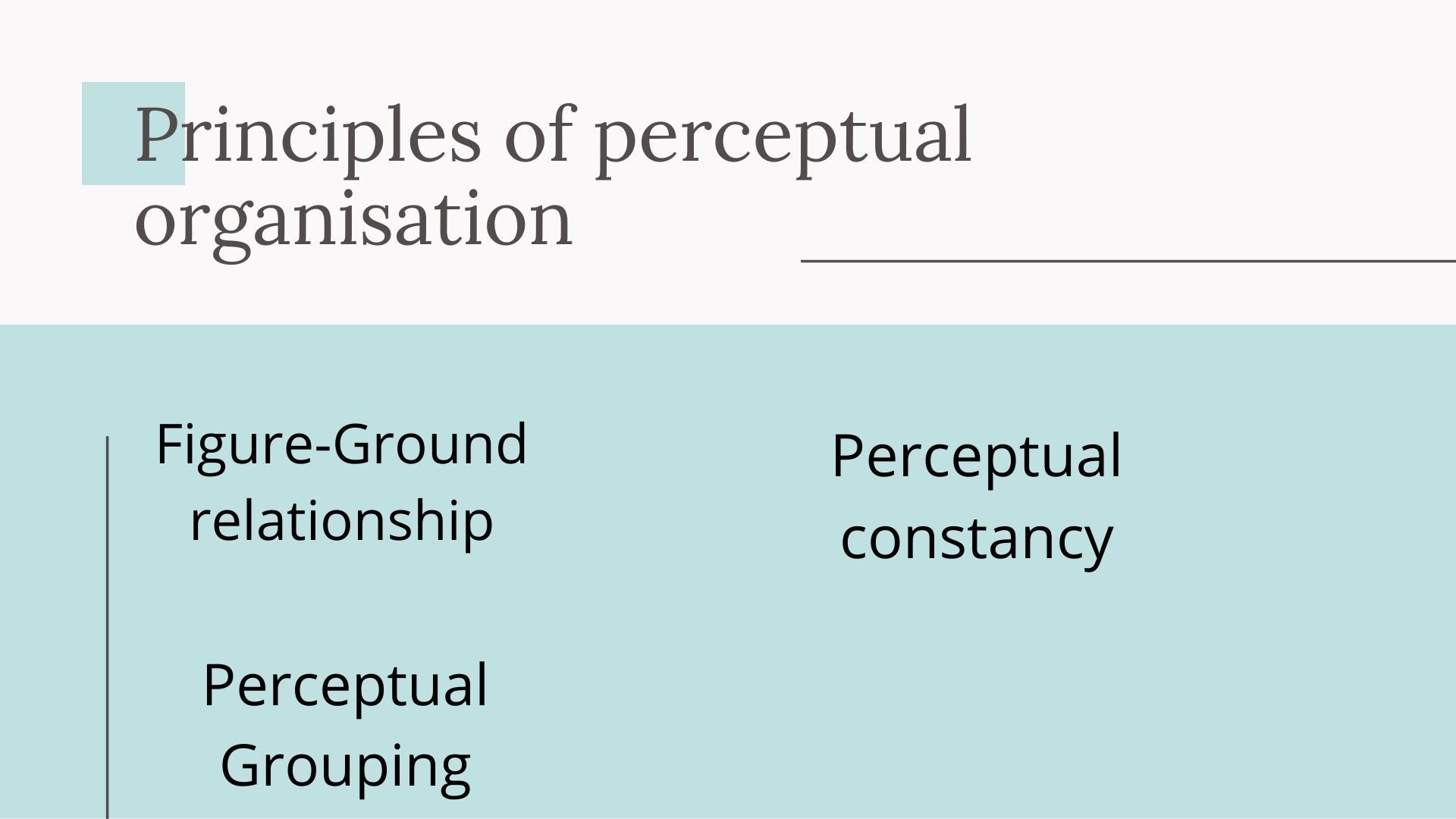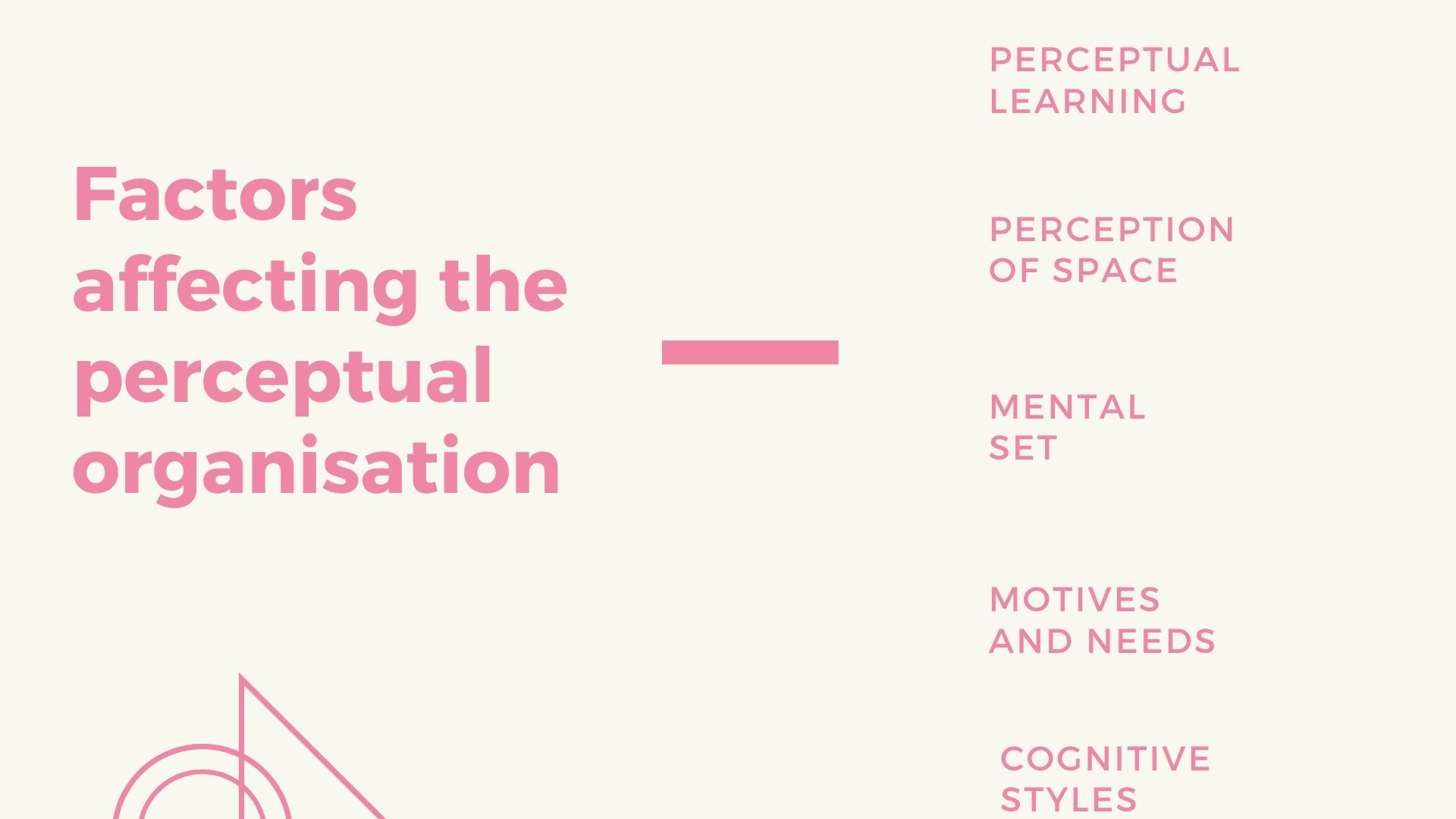Definition:
Perceptual organisation is a process that groups the visual elements so that it is easy to determine the meaning of the visual as a whole. It is an essential concept because it allows individuals to make sense of the things that they see at a rapid pace. The perceptual organisation also helps to lead the viewer to the appropriate conclusion that suits our purpose.
Table of Contents
What is Perceptual Organisation?
In everyday life, various stimuli keep on stimulating the sense organs of a human body. The sense organs are the recipient of these stimuli which are converted to sensations and transmitted to the related parts of the brain, which helps it in interpreting. This is what perception is. It involves the process of sensation as well as interpretation.
Perception is all about viewing and experiencing and this is why even two people can’t see similar objects the same way. The information that we have access to governs our beliefs and mindset. It is ultimately the perception that leads to individual interpretation, and this is why everyone sees things in their way.
Perceptual selectivity is about external and internal variables, and the perceptual organisation is about organising inputs into whole objects that can be easily identified. It is the perceptual process of an individual that takes into account the incoming information and gives it a meaningful picture. It is also defined as an integrated approach where different psychological and physiological processes like mental state, clarity of sensations and accuracy of sense organs are involved so that the perception does not go haywire.
Several factors play a prominent role in the perceptual organisation theory. These principles or laws can explain the way perception acts independently from the features and characteristics of individual stimuli. It has been proved that human perception sometimes has little connection to the stimulus situation in hand. There is a reason for it as perception is an active and complicated process that is influenced by numerous other factors besides the stimulus characteristics.
Understanding perceptual organisation
A well-known American origin psychologist William James has aptly described that human beings generally do not see objects or things as they appear but view them as they want to. The perceptual organisation is a synthetic process where the human mind selects specific stimuli through its attention and interprets it as per its directive. Similarly, other stimuli in the visual or audio field select stimuli and organise into a form that will be perceived in a more meaningful way than it appears.
The perceptual organisation theory has been aptly explained by Gestalt psychologists who believed that the human brain is capable of creating a conscious perceptual experience by observing the stimulus as a whole and not as the total of its parts. Remember, it is the stimulus that plays an integral role in the perceptual organisation theory.
Principles of perceptual organization
The Gestalt laws of perceptual organization theory are based on the following groups of rules or principles
Figure-Ground relationship –As per the principle of figure-ground relationship the human brain can perceive a figure in a meaningful manner in the background and the beauty of it is that it cannot be separated from that perceived background.
Perceptual constancy – As the name suggests, the term perceptual constancy is about stability in perception. The tendency of the human mind to perceive objects as unchanging and stable in size and shape despite a change in the picture we receive is referred to as perceptual constancy. The concept of perceptual constancy depends upon numerous factors, for instance, imagination, learning, cognitive styles, motivations, habits, expectancy and experience. The different types of perceptual constancies are size constancy, brightness and color constancy, shape and size constancy etc.
Perceptual Grouping – The tendency of the human mind to group several stimuli in an easily recognizable pattern is known as a perceptual grouping. In this principle, the grouping is based on closure, continuity, similarity, inclusiveness, pregnant and proximity. A detailed description of every one of them is as follows-
- Law of Closure – The tendency of the human mind to fill in the gaps and perceive meaningful objects is simply known as the law of closure as it closes the gap in literal terms. As per the reports of Gestalt psychologists when the human mind receives sensations that are unfinished or incomplete sound or visual image, then it tries to neglect the incomplete picture. Instead, it observes the sound or picture as a finished or whole unit. This inclination is referred to as closure.
For example, draw a circle in a paper and do not close it. When you show this figure to someone else, the first thing that he will see is a circle, and it is later when the incompleteness of the circle will register in his mind. This is because his mind has already perceived the figure as a circle. After all, the law or principle of closure was in operation.
- Law of Pragnanz – The term pragnanz means good figure, and this is why the law of pragnanz is often referred to as the law of simplicity or law of good figure. It describes the tendency of a human mind to perceive the objects in an environment in as simple a manner as possible. For example, draw a few rectangles that are interconnecting each other. Although the end picture has now some different shapes as well the human mind will see it as some rectangles because it will be the most simple and easiest figure to identify in the brain. This is why the term pragnanz is used for this law as it depicts completeness or fullness of the picture.
As per the reports of Gestalt psychologists, the process of perceptual organisation is dynamic and will keep on changing until it reaches a stage that the human mind will see as complete, with maximum meaning and simple to understand. At this point, the gestalt or the perception remains stable and is for this reason known as a good gestalt.
As per the Gestalt psychology, perceptual organisation process will try to move forward towards a good gestalt. One of the underlying mechanisms to describe the law of pragnanz is the law of closure. For instance, it is seen that a child will go on asking questions until and unless his mind is satisfied. This is because he is looking to understand his perception of a specific thing.
- Law of Proximity – The law of proximity describes the tendency of a human mind to perceive the objects that are near to each other as if they are grouped. It is the human mind that segregates objects in groups as per its perception. Draw six circles in a straight line with a space of half-inch between the first four and one inches for the last two. The human mind, in most cases, will perceive them as two groups one of four circles and the other of two circles. This is because the objects are closer to one another in both groups.
The law of proximity in the perceptual organisation theory tends to perceive objects that are closer to each other as a single entity and not as separate. Even if the individual items are not connected, it will be seen as a meaningful picture and grouped under as a single entity or pattern.
- Law of Similarity- The law of similarity describes the tendency of a human mind to perceive the objects that are similar to a single group and not as individual entities. The grouping can be of both sound and visual stimuli. The law of similarity in perceptual organisation theory states that stimuli that have the same colour, shape and size are deemed as together and considered in a pattern because of similar nature.
- Law of Continuity – The law of continuity as the name suggests describes the tendency of a human mind to perceive the objects that extends itself into space in a similar pattern of colour, size and shape without a break, a whole figure. For example, if the points are connected by a curving or a straight line rather than seeing separate lines, they will seem as one entity because of the law of continuity.
- Law of Inclusiveness – The law of inclusiveness, describes the tendency of a human mind to perceive the objects of a pattern more readily than other figures. For example, if you draw big dots in the form of a circle and then small dots in the shape of a rectangle in its middle, then the viewer will perceive the outer dots of the circle more readily compared to the smaller ones within it. The outer dots acted as an enclosure or only a fence and were prominent, thus could be easily identified by the mind.
Factors affecting the perceptual organisation
The factors that affect the perceptual organisation are as follows-
1. Perceptual learning
The best teacher of perceptual learning is experience. Human beings tend to put their onus on some of the sensory inputs and ignore others if they have received any specialised training. For instance, if a person has trained in a skilled job like the painting, he will have a better knowledge about colours and art than people who are untrained in that specific field.
In another example, a newborn baby will identify his mother by the voice or her smell. It is the perception that helps him to do so. Similarly, a blind man will be able to identify people by their sound.
2. Perception of space
The factor that can affect perceptual organisation is the perception of space by a human mind. As per this concept, a person tends to see an object in the environment and perceive it in three dimensions width, height and distance.
3. Mental set
Another essential factor that affects perceptual organisation is a mental set. The term refers to the readiness of a human mind to receive sensory input. This is a type of expectancy that keeps a person prepared with the right concentration and attention span.
This concept that affects perceptual organisation can be easily explained through an example. When you are standing inside a metro station, the arrival of a metro train can be identified by its horn beforehand. Similarly, when you pass a temple, you can identify it by the sound of bells ringing or chanting of verse that tells you about that religious place.
4. Motives and needs
Another essential factor that has a profound effect on the perceptual organisation theory is motives and needs. It is a proven fact that the motives and needs of a person will undoubtedly influence his perception levels. For example, if a person is thirsty, he will instantly recognise water.
Similarly, if a person has been fasting, he will immediately recognise food by the smell or by identifying the food items amongst various other products. This is because his attention is sorely directed towards fulfilling his wants and needs, and he will see only those things that he requires at that point and which can satisfy his motives.
5. Cognitive styles
If you are looking for factors that can influence the perceptual organisation, then look for cognitive styles. It is a proven fact that how a person processes any information will vary from person to person. This is because of a straightforward reason. Every individual is different, and his way of grasping things and situation is also different from the other person.
It has been proven that individuals with a flexible and outgoing nature have a healthy attention span, and this is because of their confidence level, which does not allow interfering and disturbing elements to manipulate him. The individual is also less dominated by his internal motives and needs than a person who is not so flexible and is governed by his personal needs and wants.
Looking to apply perceptual organisation principles in your marketing strategy?
Quick Tip: Incorporate the Gestalt principles, such as the law of similarity and proximity, into your branding efforts. By consistently using colors, fonts, and layouts across all marketing channels, you can enhance brand recognition significantly. According to a 2019 Lucidpress report titled “The Impact of Brand Consistency,” consistent brand presentation across all platforms can increase revenue by up to 23% (Source: Lucidpress, 2019).
Inspirational Quote: “Design is not just what it looks like and feels like. Design is how it works.” – Steve Jobs, co-founder of Apple Inc., emphasizing the importance of perceptual organisation in creating functional and appealing designs.
Liked this post? Check out the complete series on Organizational Management



gestalt principle of perceptual organization, what factor do you think ditermine attention ?
hay sir i am bba i am dda graduate